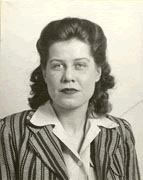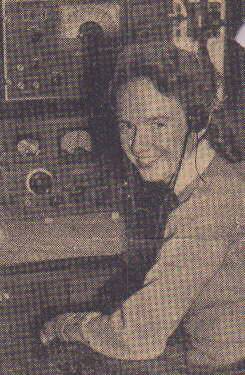 While
working as an addressograph clerk at Toronto Hydro, Maude Elizabeth Steane
enrolled at the Radio College of Canada to qualify as a Wireless
Operator - 2nd Class.
While
working as an addressograph clerk at Toronto Hydro, Maude Elizabeth Steane
enrolled at the Radio College of Canada to qualify as a Wireless
Operator - 2nd Class.
She began her night-school training in June of 1942 and completed her
requirements fifteen months later, graduating second in her class.
In late May of 1944, she joined the merchant ship S.S. VIGGO
HANSTEEN at New York. The HANSTEEN was an
American-built Liberty Ship transferred to Norwegian registry for
emergency war transport.
Just ten weeks after leaving home, at the age of 28, Maude Elizabeth
Steane was murdered aboard the HANSTEEN while anchored off Naples,
Italy. She was shot by a male crew member who then turned the gun on himself.
She was the first woman from Toronto killed on active service. She is buried
in the Allied War Cemetary at Florence, Italy.
Condolences were expressed to her family by the Norwegian Consul
General at Toronto.
At the conclusion of the war, there were a small number of other
Canadian women who found their way up the gangways of Norwegian vessels.
Lylie Smith shipped out in '46 but prior to that she had been
the first girl radio operator hired by the Hudson's Bay Fur Trade
Co. for their northern posts. Possibly the longest at sea of any
of the Canadian YLs, Lylie's travels took her to the Far East, South
America, the U.S. and Europe.
Four young women who had served as interceptor operators for the
government during the war headed for the sea as soon as an opportunity
arose. Anna Ozol was one of these and, while her first ship is not
known, it was while serving aboard the m/v Skaubo in the
late summer of '49 that Anna achieved the doubtful distinction of being
one of the few women to send out an SOS. Skaubo had taken on
a severe list while about 500 miles off the U.S. West Coast when the
ship's cargo of soft ore concentrate shifted during a storm. Happily the
vessel was able to make port without aid.
 In
early '47 Anna was followed to sea in quick succession by Elizabeth
King, Norma Gomez and Olive Carroll. Elizabeth flew off to San
Francisco to join her first ship, m/v Vito, where she served
for a year and a half. After a lengthy holiday ashore Elizabeth signed
aboard the m/v Skauvann, leaving the sea for good in '51.
She sailed the Pacific routes; her voyages taking her from Japan down to
Australia, and ports in between.
In
early '47 Anna was followed to sea in quick succession by Elizabeth
King, Norma Gomez and Olive Carroll. Elizabeth flew off to San
Francisco to join her first ship, m/v Vito, where she served
for a year and a half. After a lengthy holiday ashore Elizabeth signed
aboard the m/v Skauvann, leaving the sea for good in '51.
She sailed the Pacific routes; her voyages taking her from Japan down to
Australia, and ports in between.
All things considered, Norma Gomez was the unlucky one. Her
first and only ship was the Lutz, a small coastal vessel
which carried newsprint from B.C. to U.S. West Coast ports.
Accommodations on the ship were quite primitive, as was the radio
set-up, and Norma retired six months later.
Olive Carroll was the last of these former interceptor
operators to join the Norwegian MN. She replaced Esther Crichton
on m/v Siranger in April '47, a service that would last
four years and cover much of the world.
In the early '70s Dallas Bradshaw of Victoria went to England
for training, becoming, it is said, the first woman operator to sail
aboard a British ship, the ore carrier m/v Duncraig. Being
a Marconi operator Dallas no doubt served aboard a number of other
vessels and she was still at sea in '74 aboard the Naess.
Perhaps last of these Canadian YLs, and certainly not the least, was Aja
Vibeke Norgaard Gron who sailed aboard a Danish vessel. Her name has
been passed on but nothing is known of her ship or experiences at sea.
Ships' wireless operators have now
gone the way of the Dodo bird, a brief chapter in maritime history.
Canadian woman operators were pioneers who played but a small part in
the annals of sea-going Sparks - but they are deserving of remembrance.
Thank You To:
Olive Roeckner VE7ERA - Wrote Text and Author of Deep Sea Sparks
Fred Addis, Maritime Historian, Toronto - for Ship Photographs and
Information
Royal Canadian College (RCC) for 1942 First Graduating Class of
Wireless Operators and Maude Steane's Photographs
Copyright
�

Back to Top

 YLRadio Home
YL
Archives
YLRadio Home
YL
Archives 

1999 - 2011